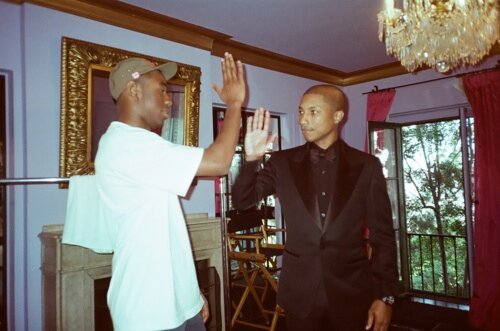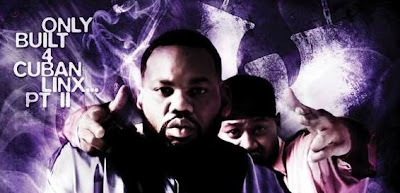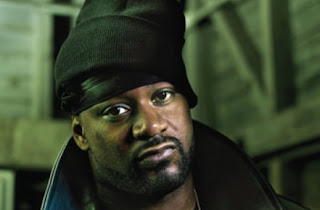In that ‘Time’ magazine cover-story on Kanye West a few years ago, comedian Chris Rock described Kanye’s appeal through his connections to an earlier, less Jeezy-friendly era of hip-hop: “In the early days, the best rappers weren’t necessarily from the hood. Run-D.M.C was from Hollis. Eric B and Rakim were from Long Island. They lived next to the hood.” This quote rumbles around in my head a lot, because it’s a great, to-the-point piece of rap criticism that describes rap’s appeal: Rap’s ability to both be rooted in the reality of an experience and step outside of it and provide commentary, at the same time. Rock’s one-liner is a little problematic because it implicitly connects hood to bad but what he’s basically saying, if you stretch it to a generality, is that the best artists are connected to their environment but also a little outside of it all. This allows artists, and especially rappers to adopt the first-person or engage in a very sympathetic understanding of others, while never being tied completely down by the closed-mindedness of whatever subculture one belongs to and that extends beyond “the hood”.
Henry James is “next to the hood” in the sense that he’s both of the upper-class his novels document, but also beyond it: he doesn’t simply justify the upper-class, nor is he a knee-jerk, self-loathing critic of it all…he falls somewhere in between. “Next to the hood” however, makes the most sense for rap because well, there’s really no other artform like it, where it occupies this pretty-much-inexplicable space between “truth” and story and real and fiction and morality and immorality (to continue my douchey high-brow references, rap is amoral in the way that Oscar Wilde meant it in the Preface to ‘Dorian Gray’…). I said it before, but Chuck D’s assertion that rap was “the black CNN” may have worked for certain rappers, but even message-oriented raps suggest a familiarity with that which they critique that extends beyond third-person reportage.
For example, Andre 3000 is “next to the hood” on ‘Da Art of Storytellin’ Pt. 1′ when he asks Sasha, the girl he’s “chillin’ like a villian” with, what she wants to be when she grows up and she says “alive’” and it totally blows his mind. One could say Eminem is “next to the hood”- or “next to the trailer park”- on ‘Kim’ as he both performs the actions of jealous, angry, cracker boyfriend but also critiques them: “You can’t run from me Kim, it’s us, nobody else/You’re only making this harder on yourself”. Rock’s “next to the hood” point keeps coming up in relation the new Wu Tang album, in part because of many disappointed fans and even members’ assertions that what the RZA did on ‘8 Diagrams’ was not “street” or “hood” enough but also because it, in effect, defines “next to the hood”.
On ‘The Heart Gently Weeps’- the album’s most successful and rewarding track- Ghostface drops a particularly winning “next to the hood” verse as he describes walking through Pathmark and being confronted with an angry Nephew who “wants revenge” because Ghost “murdered [the nephew's] Uncle Tim” by selling “him a bag of dope”. It’s already “next to the hood” in the sense that it breaks-down the conventional tough-guy hood stuff (he’s in Pathmark, spills milk on his Clarks/He regrets drinking/Saying “murder” is just great writing and very, very moral) but that’s just what we expect from Ghost. What really makes the verse great and indeed, “next to the hood”, is how it goes from the description of the Uncle to telling the listener that after the Uncle’s death, “his wife came and copped again” and then, he croons “that bitch is craaazzyyyy/She brought her baaabbbyyyy…”. In those two lines, you get the image of Ghostface the dealer and Ghostface the human being who sells her the drugs but in his head is thinking “whatthefuckthisbitchbroughtherbaby??!!”…this isn’t some oh-so-conflicted dealer cliche, it’s so much more than that. Not quite the same, but it recalls my own “next to the hood” moment, when I once drove this dealer-kid from school home only to discover his house was like, straight out of ‘Gummo’ and his like, 8 year-old, already-brain damaged kid brother was getting high…I still put on the act of non-chalance and “oh, that’s funny your kid brother smokes up” but inside I was like, “holy shit” (to reference ‘Fishscale’s ‘Shakey Dog’, another Ghostface “next to the hood” moment…).
Most of ‘8 Diagrams’ almost reaches this “next to the hood”-ness lyrically, the Wu are fairly on-point but seem a little guarded and uncomfortable, but that’s more age and their own fault, it’s got nothing to do with RZA’s beats which are wonderfully weird and yes, next to the hood. RZA tells his fans as much with that explanatory Kung Fu sample intro demanding “patience” and “honesty”, an honesty that even members Raekwon and Ghostface couldn’t subscribe to when they began bitching the album out before it even dropped. It is only the Wu’s impossible past reputation that makes this album a “disappointment”. When you hear these songs outside of the context of “I’m listening to the new Wu Tang album” they’re really good. When ‘Take It Back’ pops-up on Sirius’ SHADE45 or on your favorite college rap radio show or as one of 3000 songs on your iPod SuperShuffle, it’s up-there with the best rap of the year. Those sorta-Gothenburg Metal guitars on ‘Unpredictable’ don’t conflict with the Wu’s energy at all, nor do those drunken crooned choruses, ‘Sunlight’ is an evil clusterfuck that’s supposed to be an evil clusterfuck. The problems with ‘8 Diagrams’ are not the choruses but that the choruses show-up a little too-often on certain songs and that there’s no sense of control or balance…songs either don’t have hooks at all, or the song is chopped-up and the energy slowed-down by a way-too typical verse-chorus-verse structure.
Even that rigid structure succeeds on certain tracks, it builds tension on ‘The Heart Gently Weeps’ and keeps ‘Life Changes’ afloat because no one brings much of anything to this supposed ODB tribute. If there is one song that defines the limits of ‘8 Diagrams’, it’s ‘Life Changes’ which highlights pretty much of all latter-day Wu’s flaws. Ghostface doesn’t even show up and the rest of the guys drop super-short verses that just feel underwhelming and dishonest; hardly “half-short and twice strong”. They fumble through cliches of being emotionally honest instead of actually being emotionally honest and for the most part, never go beyond generalities. Exceptions are Method Man’s image of pouring out some Vodka and drinking the rest, which is compact, poetic, and an appropriate homage that never elevates or lowers his image (what’s with U-God’s “fall from greatness” line?), Inspectah Deck’s real-life emotions of loss- grief and blaming one’s self- and the GZA, when he points out that he’s recording his verse ten feet from where ODB died. The rest of the Wu act about as “hood” (in the negative sense) as they can, dropping short, hard-ass verses that perform emotions and never show any actual vulnerability. It’s all the more frustrating and symbolic of the Wu’s fragmentation that they can’t even come together or get-real in a tribute to a dead member.
I saw Wu Tang in New Jersey the night before ODB died. ODB was a no-show and towards the end of the show, Method Man acknowledged this reality to the crowd and was briefly interrupted by U-God who rambled off something about kicking Dirty’s ass for not showing and telling the crowd that if they see Dirty, tell them how mad they are and then, Method Man took the stage back and as a corrective to U-God’s lack of sympathy, he said that if we saw ODB, “tell Dirty we love ‘em”; that was a “next to the hood” moment.

 At some point in the past bunch of years, Raekwon, and company bought into the idea of 90s New York hip-hop pushed by weren’t-even-there nostalgics and not you know, what it actually sounded like. Because rap got kinda fruity, New York rap was been retrofitted into being nothing but hard-ass aggression and tough-talk. No knowledge. No insight. Just pithy, gritty storytelling. Timbs and 40s. “Cracks and weed”. Sprinkle in some Kung-Fu samples, some Killer clips and resurrect Papa Wu and you’re there. Not that all those things weren’t a part of Cuban Linx’s success, but that’s not all there was.
At some point in the past bunch of years, Raekwon, and company bought into the idea of 90s New York hip-hop pushed by weren’t-even-there nostalgics and not you know, what it actually sounded like. Because rap got kinda fruity, New York rap was been retrofitted into being nothing but hard-ass aggression and tough-talk. No knowledge. No insight. Just pithy, gritty storytelling. Timbs and 40s. “Cracks and weed”. Sprinkle in some Kung-Fu samples, some Killer clips and resurrect Papa Wu and you’re there. Not that all those things weren’t a part of Cuban Linx’s success, but that’s not all there was. From battling to sampling and anything that falls between, the roots of rap are in opposition. There’s always been a sense that indignant anger about misrepresentation, misinformation, or this-dude-did-that-and-he-shouldn’t-have type shit’s fueled the music of nearly every rap great.
From battling to sampling and anything that falls between, the roots of rap are in opposition. There’s always been a sense that indignant anger about misrepresentation, misinformation, or this-dude-did-that-and-he-shouldn’t-have type shit’s fueled the music of nearly every rap great. The latest “beat drop” from Metal Lungies uh, dropped. My beats were: “Tical” (Method Man), “North Star (Jewels)” (Raekwon), “Reunited” (off Forever), and “No Said Date” (Masta Killa):
The latest “beat drop” from Metal Lungies uh, dropped. My beats were: “Tical” (Method Man), “North Star (Jewels)” (Raekwon), “Reunited” (off Forever), and “No Said Date” (Masta Killa):